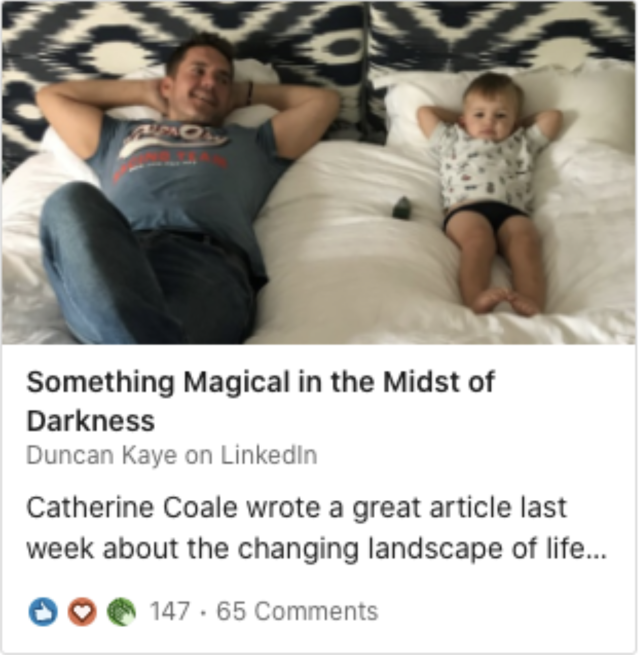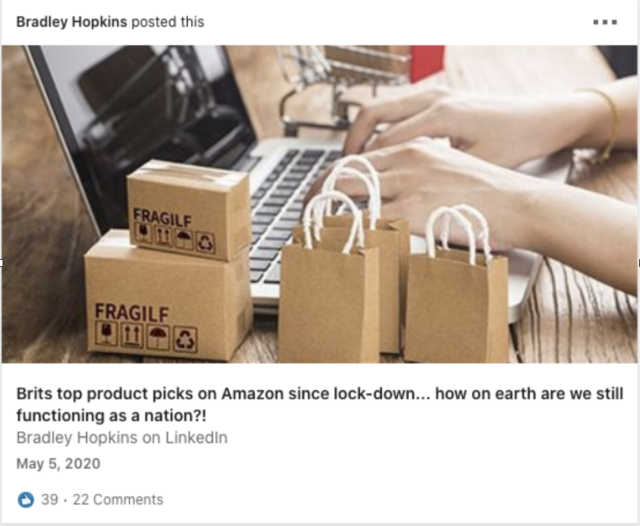I watched Alex Low going a presentation today for the Association of Professional Sales (APS) it always amazes me how Alex can turn what is a “complex” piece of software like Sales Navigator and can break it down, so it looks so easy to use. Like the old saying “how do you eat an elephant?” the answer being “a small piece at a time”.
(No elephants where hurt during that presentation, of course!)
One of the questions due Alex’s presentation was about salespeople creating content.
Let’s break this down.
Salespeople are Natural Communicators
We’ve all been in that situation where a client says we must demo next Thursday and all the resource is booked up. So what do we do? We call up our management and plead that resource is freed up, or do the same over email. Action based communication, where we state our case and guess what? Resource is freed.
A Request for Proposal (RFP) or Invitation to Tender (ITT) comes in and we write the management summary. This is where we are good at stating our case and presenting a business case.
It comes to the client demonstration and we are there as salespeople presenting the discovery and the business case to the client. We can take a complex situation, break to down and present it to the client.
As salespeople we all can write and communicate in fact we are some of the best communicators in the world.
We Often Hear Salespeople say “I Cannot Blog”
We have heard all the excuses and you can blog. In fact salespeople are some of the best bloggers I know.
Content Your Competitive Advantage as a Salesperson
When people think “content” they think Marketing. The problem for Marketing and it’s not their fault is that they work at the top of the funnel (ToFu). So they are trying to catch as many people as they can to feed into the funnel. Content is therefor generalist.
This isn’t what you as a salesperson are going to write.
3 Different Types of Content
There are three different types of content:-
- One to many – This tend to be written by marketing.
- One to Few – This is written for a Market or account, this is written by Sales People.
- One to One – This is for an account, or even a person in an account, this is written by Sales People.
Let’s Look at Some Examples:
Here Duncan has shared his experience of working from home.

So what?
It shows that he is human, not a corporate robot. People buy from humans after all.
He’s had 147 likes and 65 comments.
Let’s look at this from a conservative point of view and just look at the likes.
The average person on Linkedin has 500 contacts. A liked article is visible in the network of the person who does the liking.
This means that the article is seen by Duncan’s network, it is also seen by 147 likes x 500 average network size = 73,500
Now there are some of us that have a network bigger than 500 contacts but let’s keep the maths simple.
There is no email list that gives you 73,500 active people, who (as they are connected to you) want to see your content.
You will find that people outside Duncan’s network will see his content, there could be 73,500 x 500 people (36.75 Million) see it as Duncan’s network of his network gets visibility.

If he took 30 mins to write it and it takes 3 mins to read it he’s converted 30 mins into 220,500 minutes or let’s keep the figures conservative, he’s taken 30 minutes and converted it to 441 minutes, or 7 and half hours. Now that is an efficient way to spend your time.
Just think how long it would take him to call all 147 people and have a conversation with them. Cold calling is just so inefficient and does not scale.
Same can be said for Steve Rafferty at Ring Central. He has had 71 likes.
That’s 71 likes x 500 average network = 35,000 possible views of his blog.
Steve actually wrote a blog about the fact he had sales positions available and 40 people apply, he saved $455,000 in recruitment fees. From one blog.

Bradley, 39 likes, using the same maths, that’s 39 x 500 = a mailing list that is 19,500 contacts big.
It’s great to see Bradley as a person with humility and with an obvious business acumen.
The problem with sales today is that it’s all about interruption and broadcast. So naturally you avoid sales people or push them away.
With the examples above, it actually brings the salespeople closer to you. Reading articles you understand them for what they are, humans, with the same, wants and needs as you. You also see them as experts, people who might be able to help you in your business.
Now what do you want for your salespeople in your business? People to reject them and push them away or people to want to get to know them and buy from them?
Related: Covid19 Has Changed the Modern Buyer + Changed Sales and Marketing

